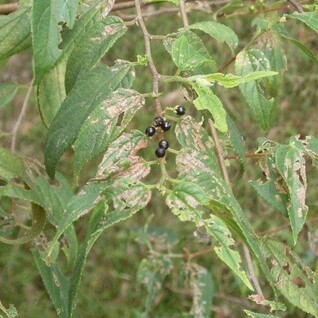Trees or shrubs, to 10 m tall. Bark grayish brown, smooth or fissured. Branchlets grayish brown to brown, densely grayish brown to gray pubescent. Stipules linear-lanceolate, 6-9 mm. Petiole 0.7-1.8 cm, pubescent; leaf blade grayish brown to black-brown when dry, 7-15(-20) × 3-7(-8) cm, abaxially with grayish brown pubescence, surface of blade visible between hairs under magnification, adaxially very scabrous with erect bristles, base cordate and oblique, margin denticulate, apex acuminate, caudate-acuminate, or rarely acute; basally 3-veined; secondary veins 4 or 5 on each side of midvein. Male inflorescences 2-4.5 cm. Female inflorescences 1-2 cm. Male flowers: subsessile, 1.5-2 mm in diam. Ovary rudimentary, obovate-oblong, compressed, transparent. Female flowers: shortly pedicellate. Tepals 4 or 5, triangular-ovate, 1-1.5 mm. Ovary glabrous. Drupes brownish purple to blackish purple when mature, compressed, 2-3 mm in diam., irregularly rugate, glabrous; perianth persistent. Seed broadly ovoid, compressed, 1.5-2 mm, ribbed. Fl. Mar-Jun (but year-round in tropical zones), fr. Sep-Nov.
Shrub or tree to 8 m high. Leaves: lamina broadly ovate to lanceolate or elliptic, 1–14.8 cm long, 0.6–5.6 cm wide, cordate to rounded, symmetrical or asymmetrical base, serrate to serrulate margin, acuminate at apex, chartaceous to thickly coriaceous, mostly discolorous, usually scabrous above, slightly to strongly scabrous to scabrous-villous to velvety below; veins 3–8 pairs, the lowest pair frequently giving a 3-veined appearance; petiole 2–11 mm long; stipules linear-lanceolate, c. 5 mm long. Inflorescence few-to many-flowered, to c. 4 cm long. Flowers globose, c. 2 mm diam.; perianth persistent. Drupe ovoid, 3–3.5 mm long, 2–3 mm wide, black.
A shrub with several stems. It grows 4 m high. The stems are covered with stiff hairs. The leaves are alternate. They vary in shape but are oval. They can be 2-13 cm long by 1-5 cm wide. The leaves are rough to touch. The leaves have teeth along the edge and a pointed tip. They are paler underneath. The flowers are green or white. They are on short stalks in the axils of leaves. The male and female flowers are separate on the same plant. The fruit are fleshy and round. They are 3 mm across. They occur in bunches are change from green to black as they mature.

